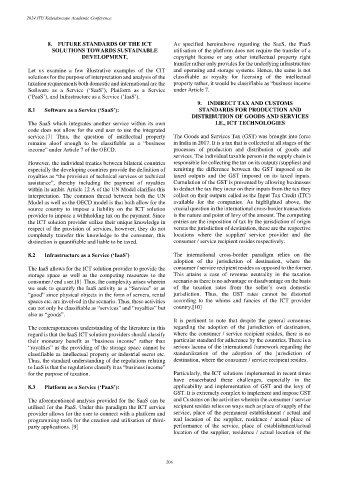Page 250 - Kaleidoscope Academic Conference Proceedings 2024
P. 250
2024 ITU Kaleidoscope Academic Conference
8. FUTURE STANDARDS OF THE ICT As specified hereinabove regarding the SaaS, the PaaS
SOLUTIONS TOWARDS SUSTAINABLE utilisation of the platform does not require the transfer of a
DEVELOPMENT. copyright license or any other intellectual property right
transfer rather only provides for the underlying infrastructure
Let us examine a few illustrative examples of the CIT and operating and storage systems. Hence, the same is not
solutions for the purpose of interpretation and analysis of the classifiable as royalty for licensing of the intellectual
taxation requirements both domestic and international are the property rather, it would be classifiable as “business income
Software as a Service (‘SaaS’), Platform as a Service under Article 7.
(‘PaaS’), and Infrastructure as a Service (‘IaaS’).
9. INDIRECT TAX AND CUSTOMS
8.1 Software as a Service (‘SaaS’): STANDARDS FOR PRODUCTION AND
DISTRIBUTION OF GOODS AND SERVICES
The SaaS which integrates another service within its own I.E., ICT TECHNOLOGIES
code does not allow for the end user to use the integrated
service.[7] Thus, the question of intellectual property The Goods and Services Tax (GST) was brought into force
remains aloof enough to be classifiable as a “business in India in 2017. It is a tax that is collected at all stages of the
income” under Article 7 of the OECD. processes of production and distribution of goods and
services. The individual taxable person in the supply chain is
However, the individual treaties between bilateral countries responsible for collecting the tax on its outputs (supplies) and
especially the developing countries provide the definition of remitting the difference between the GST imposed on its
royalties as “the provision of technical services or technical taxed outputs and the GST imposed on its taxed inputs.
assistance”, thereby including the payment of royalties Cumulation of the GST is prevented by allowing businesses
within its ambit. Article 12 A of the UN Model clarifies this to deduct the tax they incur on their inputs from the tax they
interpretation. The common thread between both the UN collect on their outputs called as the Input Tax Credit (ITC)
Model as well as the OECD model is that both allow for the available for the companies. As highlighted above, the
source country to impose a liability on the ICT solution crucial question in the international cross-border transactions
provider to impose a withholding tax on the payment. Since is the nature and point of levy of the amount. The competing
the ICT solution provider utilize their unique knowledge in entries are the imposition of tax by the jurisdiction of origin
respect of the provision of services, however, they do not versus the jurisdiction of destination, these are the respective
completely transfer this knowledge to the consumer, this locations where the supplier/ service provider and the
distinction is quantifiable and liable to be taxed. consumer / service recipient resides respectively.
8.2 Infrastructure as a Service (‘IaaS’) The international cross-border paradigm relies on the
adoption of the jurisdiction of destination, where the
The IaaS allows for the ICT solution provider to provide the consumer / service recipient resides as opposed to the former.
storage space as well as the computing resources to the This attains a case of revenue neutrality in the taxation
consumer / end user.[8] Thus, the complexity arises wherein scenario as there is no advantage or disadvantage on the basis
we seek to quantify the IaaS activity as a “Service” or as of the taxation rates from the seller’s own domestic
“good” since physical objects in the form of servers, rental jurisdiction. Thus, the GST rates cannot be distorted
spaces etc. are involved in the scenario. Thus, these activities according to the whims and fancies of the ICT provider
can not only be classifiable as “services” and “royalties” but country.[10]
also as “goods”.
It is pertinent to note that despite the general consensus
The contemporaneous understanding of the literature in this regarding the adoption of the jurisdiction of destination,
regard is that the IaaS ICT solution providers should classify where the consumer / service recipient resides, there is no
their monetary benefit as “business income” rather than particular standard for adherence by the countries. There is a
“royalties” as the providing of the storage space cannot be serious lacuna of the international framework regarding the
classifiable as intellectual property or industrial secret etc. standardization of the adoption of the jurisdiction of
Thus, the standard understanding of the regulations relating destination, where the consumer / service recipient resides.
to IaaS is that the regulations classify it as “business income”
for the purpose of taxation. Particularly, the ICT solutions implemented in recent times
have exacerbated these challenges, especially in the
8.3 Platform as a Service (‘PaaS’): applicability and implementation of GST and the levy of
GST. It is extremely complex to implement and impose GST
The aforementioned analysis provided for the SaaS can be and Customs on the activities wherein the consumer / service
utilised for the PaaS. Under this paradigm the ICT service recipient resides relies on ways such as place of supply of the
provider allows for the user to connect with a platform and service, place of the permanent establishment / actual and
programming tools for the creation and utilisation of third- real location of the supplier, residence / actual place of
party applications. [9] performance of the service, place of establishment/actual
location of the supplier, residence / actual location of the
– 206 –

